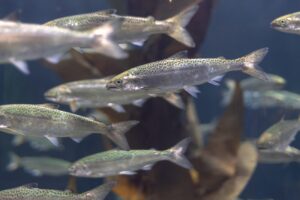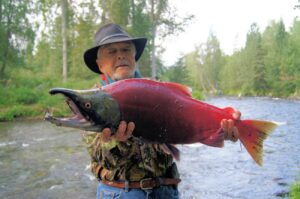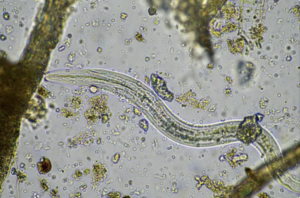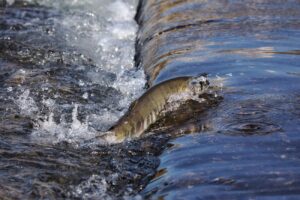This is a good review and update of the problems and challenges facing the aquaculture industry. Otherwise ignore the bias. The first problem ignored by everyone is that the wild catch has steadily declined as a delivered fraction of our seafood intake.
Fact is that the wild catch cannot ever deliver enough product and should not. As well habitat restoration and augmentation has really only begun. We are now removing dams.
augmentation also properly combines wilderness husbandry with agriculture. Imagine the Maitland river basin in Midwest Ontario supporting a full beaver population and a Pacific Northwest Biome. All the salmon species have already been introduced to the great lakes..
now imagine all this totally penetrating our boreal forest. After all, our boreal forest is a mere 10,000 years old and barely evolved while the Pacific Northwest rotates into Alaska and is millions of years old.
Essentially Salmon aquaculture did not ex8st in my lifetime. It is slowly getting better. It will get infinitely batter as we add centuries of husbandry.
The Farmed-Fishing Disaster
November 26, 2024
Problems in the Tank

In the 21st century, wild fish are are being replaced with farmed fish, as livestock, in the aquaculture industry.
However, the growth of aquaculture has come at the expense of the environment and the health of the fish. This results in the potential for major disease problems and food safety issues, according to a 2022 article in Frontiers Immunology.
As livestock, fish succumb to the same synthetic treatments as other commercial livestock. According to MDPI, a member of the United Nations Global Compact, in the name of Sustainability: vaccines have a significant role in managing live stocks.
Vaccines have been applied as “preventive measures” in fish to reduce the chance of diseases such as rabies, as well as parasitic and bacterial pathogens, which occur as part of the commercial farming process. Rabies in fish? [That is another fish story for another time]. Meanwhile…
Salmon farms, consequently, are ideal incubators for parasites and infectious diseases that are then spread to adjacent farms and to wild fish. These outbreaks are impossible to quarantine; mass escapes from salmon farms and the normal flow of tides and currents spread diseases and parasites to other fish over very wide areas.
Even though fish are not of the animal kingdom, fish vaccines are delivered in the same way as warm-blooded animals. If we investigate all modes and vectors of disease transmission then we can also say that disease-causing pathogens may also be introduced through live-attenuated vaccines.
A vaccine contains an agent resembling a disease-inducing microorganism– a bacterium, virus or toxin – that activates the body’s immune system. A vaccine is essentially a pathogen-imposter. —Carrington College,
A Fish Story
Fish story: noun, an extravagant or incredible story

The $20-billion-a-year farmed salmon industry is the world’s fastest growing food producer, and it has made farmed Atlantic salmon the most popular fish on dinner tables North America. But at what cost?
As early as 2004, scientists found levels of polychlorinated biphenyls, a probable carcinogen known as PCBs, seven times higher in farmed Atlantic salmon than in wild salmon. In addition:
Untreated waste from excess feed, decomposing fish, excrement, and chemical residue forms a toxic stew that kills or drives away marine life for hundreds of yards.
The management of farmed fish includes antibiotics, probiotics, injectable vaccines, breeding maintenance, nano-based drugs, and edible vaccines, all with monitoring requirements. Of course, disease resistant mutant strains result from antibiotic treatments. Hence, the vaccine program. When it comes to drug use in global aquatic products:
Long-term use of chemical inputs not only increases pathogenic bacteria resistance but also damages the fish and aquaculture environments, resulting in drug residues in aquatic products.
Disaster in the Making
In 2021, 81,000 fish escaped from an open-pen fish farm in Norway. In 2023, thousands of fish escaped an Icelandic farm. Escapees have been found in at least 32 rivers across north-west Iceland, many covered in deadly sea lice, lethal to wild fish. Escapees also breed with wild fish to cause wild fish declines.
A 2012-2022 study determined that 865 million farmed salmon have died in mass die-offs in the last decade due to aquaculture practices and technologies.
It’s the same old fish story, replayed over and over. When any life form is placed in crowded unsanitary conditions, and genetically modified, it becomes a pre-medicated disaster, for generations to come.
“In today’s fish-eat-fish world, you either take or you get taken.” Productivity runs economies! The result? Wild caught fish are harder and harder to find. Thus, commercially-farmed, diseased fish will be served up at restaurants, and at home until none are left.
You’d think cooking would destroy the parasites. But destroying the nematodes at 145 degrees is like cooking a burger well-done. – Harold McGee, Food and Cooking, 2016
A Medley of Injectables
If you’ve ever had tetras in your aquarium, you have supported the Glofish industry of genetically modified fish injected with florescent dyes. Glofish are one symptom of an injectable aquaculture. If you are a Koi Hobbyist, you will be told to inject vaccines. Whether injected with dyes, dipped in chemicals, or tattooed, the fish have not given their permission to painfully modify their body. To reduce death by dyeing, simply avoid purchasing modified fish.
The aquaculture industry is suffering significant financial losses as a result of the worsening water quality and increasing frequency of aquatic disease outbreaks caused by the expansion of aquaculture. However, vaccination, is still the answer.
According to a review of aquaculture vaccine technologies, old technologies of killed and live-attenuated vaccines, are being replaced with a new generation of recombinant, synthetic peptides, mucosal vaccines, subunit, DNA and RNA vaccines, nanoparticle-based and plant based edible vaccines, reverse vaccinology, and monovalent and polyvalent vaccines.
Parasites in Farmed Fish
Farmed salmon are bred to grow fast in cages so crammed that they are rife with parasites and disease. The fish eat pellets of fishmeal, vegetables, and animal byproducts; they are doused regularly with pesticides and antibiotics. – Time Magazine, July 2022

Do not assume that just because the fish are vaccinated that parasites do not still live on or in their slippery bodies. Conditions of overcrowding and poor sanitation have always been indicators of disease and infection in farmed animals, even in organically-farmed pork. In this way, the spironucleosis parasite can infest farmed fish through the freshwater source in hatcheries:
The parasite has been detected in wild salmonids living in freshwater that is used as a water source for hatcheries, which therefore represents a potential source of infection that we must try to control. — Lill-Heidi Johansen, scientist and project manager at Nofima.
While parasites (in the larval stage) can be eaten in uncooked, or undercooked, unfrozen wild seafood, they are also present a human health hazard in cooked farmed fish.
Salmon farms harbor two especially virulent parasites: sea lice and kudoa (soft-flesh syndrome). Sea lice infestations have been reported by operators in Canada, Norway, Scotland, and Ireland. – Pure Salmon Campaign
If you dine only on wild caught fish, be aware that parasites found among wild caught species are the nematodes or roundworms: (Anisakis spp., Pseudoterranova spp., Eustrongylides spp. and Gnathostoma spp.), cestodes or tapeworms (Diphyllobothrium spp.) and trematodes or flukes (Chlonorchis sinensis, Opisthorchis spp., Heterophyes spp., Metagonimus spp., Nanophyetes salminicola and Paragonimus spp.).
Farmed fish may be more resistant to the anasakis parasite infection. But, that is only one parasite studied. As always, more studies are needed.
The fish spend two to three years in open-net farms that contain up to a million salmon jammed into 10 or 12 cages, which extend 30 feet below the surface and are anchored to the seabed. The crowded cages are petri dishes for tiny parasites called sea lice. —Time Magazine, July 2022
Know Your Fish

Not long ago, wild Atlantic salmon were an abundant species, living free. Today, they are an endangered species, gone from most rivers in the U.S.. Claims made by farmers that their fish are sustainable and natural are deceptive. Most consumers rarely have enough information to go on.
Up to 85 percent of the salmon we eat is imported from farms along the coasts of Norway, Chile, Scotland, and Canada. Yet the Food and Drug Administration, which is responsible for food safety, pays scant attention to farmed salmon at a time when food-borne pathogens are on the increase. —Time Magazine, July 2020
According to the book, Salmon Wars: The Dark Underbelly of Our Favorite Fish, a single meal per month of farmed Atlantic salmon can expose consumers to contaminant levels exceeding standards from the World Health Organization. The risk is greatest for infants, children, and pregnant women. The authors, in their article, 3 Reasons to Avoid Farmed Salmon, suggest “farmed Atlantic salmon from open-net pens is off our menu and should be off yours.”
So much for Sustainability.

No comments:
Post a Comment